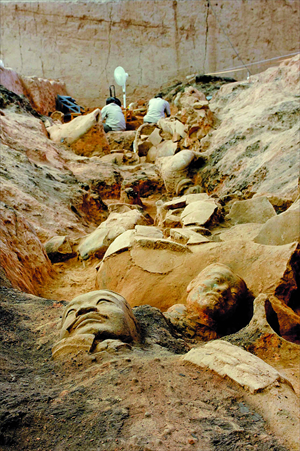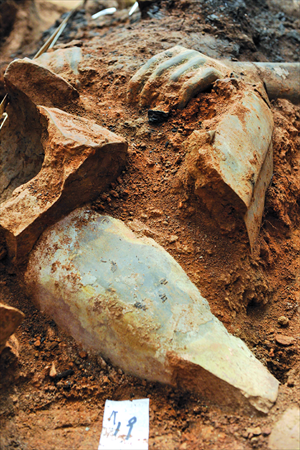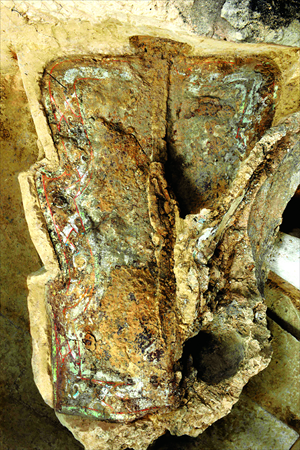Digging for clues in ancient Qin



After three years of archeological work on Pit 1 of the Terracotta Army in Xi'an, the capital city of Shaanxi Province, the results debuted to the public in early June. Experts unearthed over 310 pieces of historical relics, including a large number of new terracotta warriors, 12 pottery horses, two chariots, weapons and tools, and decayed building materials.
"All the warriors unearthed in the latest excavation were very realistic, with astonishing lifelike black pupils, complete with the whites of the eyes," Shen Maosheng, head of the archaeological team for the third excavation of Pit 1, told the Global Times.
All the terracotta warriors were initially covered with colorful drawings. However, the low quality of colored tools used in the Qin Dynasty (221BC - 206BC) combined with later man-made damages resulted in most of the colors eroding after exposure to the air, during the excavation.
Gems found
A painted shield measuring 50 centimeters wide and 70 centimeters tall was discovered on the surface of a chariot relic. This is the first of its kind unearthed among the pits of terracotta figures.
According to Yuan Zhongyi, an expert on the excavation of terracotta figures, the shield probably equipped for soldiers for fighting in the chariot.
"The shield proved that the soldiers in the Qin Dynasty took good care of themselves in war, overturning previous assertions that ancient soldiers were brave enough to fight unprotected. In fact, they were equipped with suits of armor," Shen said.
A contrast from traditional military warriors, a pit of lively performer figures was unearthed in the third excavation. Most performers were naked from the waist up; some even sporting beer bellies. One figure measured 2.5 meters. The discovery of these figures added a new category to the terracotta warriors in the Qin Dynasty, according to the excavation team.
"The third excavation is more detailed than previous ones. For example, we immediately photographed and collected samples of the textile remains at the moment of discovery, and sent them for further verification to test their properties...We attached more importance on conducting multidisciplinary research. Experts in related fields have all participated in the excavation," Shen told the Global Times.
The discovery of textile products is profound for the research of the textile history of Qin Dynasty, according to Xu Weihong, the researcher in charge of the latest excavation.
Mystery solved?
The reason for the burning of the terracotta warriors and horses remains a mystery. The first proposition attributes it to funeral customs, for pits of terracotta warriors burnt for the burial service of Emperor Qin Shihuang (259BC - 210BC), the first emperor of Qin Dynasty.
"This lacks evidence," Shen said. "As we can see, Pit 3 was not burnt at all."
The second idea, that the pits spontaneously ignited, is also vetoed by Shen. "The pit didn't have enough flammable material like wood to create a fire, and there was not enough oxygen inside the pits to burn," he said.
"We support the third hypothesis that the fire was deliberately set by Xiang Yu (232BC-202BC), a prominent military leader who wanted to overthrow the Qin Dynasty and his soldiers. As we can see, many terracotta figures were badly destroyed by artificial factors. Carbon dating traces the burnt leather and ropes close to the dates when the terracotta warriors were placed in the pits. According to The Historical Records (Shi Ji), Xiang Yu burnt the palaces of the Qin Dynasty and the mausoleum of the Empire Qin Shihuang, when he dispatched troops in Xianyang, the capital of Qin Dynasty," Shen told the Global Times.
The third excavation of Pit 1, which formally started on June 13, 2009, was set to finish in two to three years, according to Cao Wei, the curator of The Museum of the Terracotta Warriors and Horses of Qin Shihuang.
"We will work on a 200-square meters archeological field in the next two or three years. We expect to discover different military forces of terracotta warriors and their weapons, which will be useful for the research of combat formation as well as metallurgy and pottery techniques in the Qin Dynasty," Shen said.
Gong Rui contributed to the story